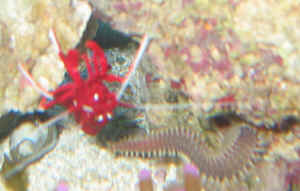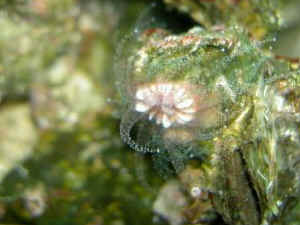|
FAQs about Live Rock Hitchhiker/Creature
Identification 2
Related Articles: Live Rock, Answering
Some LR FAQs by James Fatherree, Live
Rock, Reef Systems, Refugiums,
Related FAQs: LR
Hitchhiker ID 1, LR Hitchhiker ID
3, LR
Hitchhiker ID 4, LR Hitchhiker ID
5, LR ID 6, LR Hitchhiker ID 7, LR ID 8, LR ID 9, LR ID 10, LR ID
11, LR ID 12, LR ID 13, LR ID
14, LR ID
15, LR ID 16, LR ID17 LRID 18,
LRID 19, LRID
20, LRID 21, LRID 22, LRID
23, LRID
24, LRID 25, LRID 27, LRID 28,
LRID 29,
LRID 30, LRID 31,
LRID 32, LRID 33,
LRID 34, LRID 35,
LRID 36, LRID 37,
LRID 38,
& Non-Vert IDs 1, Tubeworm ID, Polychaete Identification, Live Rock 1, LR
2, LR 3, LR 4, LR 5, Curing Live Rock, Live Rock Selection, Shipping/Moving, Placement, Lighting, Water Quality, Live Rock Studies in Fiji Collaboration
& Charts, Copper Use, Marine Landscaping, Marine Biotope, Sumps, Refugiums, Faux
Rock,
|

|
Filter feeding sea cucumber in rock ID 4/22/04 Hello Crew...
<howdy> As my tank continues to mature, I find more things to ID.
(Beats the alternative!) Most I have been able to research but from
time to time something pops up that evades me. I have attached two
photos of one of my live rocks. There is something growing out of the
rock that looks like tree branches. They are white and almost clear. In
one photo you can see what appears to be a base attached to the rock.
These are growing on one particular rock in about three places. You
probably have a huge section in the FAQ but I have yet to find it.....
<they are harmless filter feeding sea cucumbers like the
Phyllophorid described on page 307 of our book, Reef Invertebrates>
Also, I have noticed schools of some unidentified critters deep within
the various holes of my LR. I have tried to photograph these with no
luck. I can only describe them as just big enough to see with the naked
eye, moving around very quickly in schools. If you have ever walked out
at night and noticed gnats swarming a light, that is what this looks
like. They are very small (little dots) but they are moving in the
water (not on the rock). <sounds very much like swarming
copepods... a good sign> I have developed a large amphipod
population and I thought these might be newbies. <nope... no
swarming of Amphipods. The babies scurry like the parents along the
rocks> I know my description is lacking but I can't catch one to
look at it as they are in the holes of my LR and never seem to come out
into the main water column. <no worries> Lastly, I have a fairly
new green button polyp (one frag) that has been in my tank for about
one week now. He opened up right away but after a couple of days, he
stopped opening. Still looks alive and every now and then he will just
open enough so I can see a bit of green but he has not fully opened
since day two. Everything else is acting normal. ?? He is close to my
leather toadstool (frag) since he came on the same rock. <it may
simply need some days or weeks even to acclimate to the new
lighting/water quality. Please do not stress it with a move in the tank
but rather leave it be with patience to acclimate> 20 gallon - 130W
(2x65) PC Custom Sealife w/moonlights Temperature -- 80 f. pH -- 8.2 -
8.3 Specific Gravity -- 1.023 - 1.024 Calcium @440 ppm Alkalinity @
11.6 dKH. Ammonia 0.0 I don't have any fish. I have all softies
(zoos, xenia, leather toadstool, button polyp, green star polyps with
some hermits, snails and a cleaner shrimp.) Thanks for a great
site. My only complaint is the FAQ's are stealing my sleep!! Keith
<best regards, Anthony>
|
Could you ID this (live rock hitch hiker) Several of
these are growing on my live rock. Any idea what they are? Thanks
for your help. <They are non-photosynthetic stony corals. They
are probably of no danger to any typical reef tank inhabitants,
and will not reproduce fast enough to become a problem. They will
require a fair amount of food to survive, so you may want to
target feed them bits of chopped meaty food. Nice find! Best
Regards, Adam>
|
|

|
LR Critter (1/14/04) Hi Bob, <Steve Allen tonight> I
have been running a salt water tank for about a month now. I
bought live rock for it and noticed some strange 'thing' on it.
<LR usually has lots of interesting critters.> I talked to the
store where I bought it and they couldn't help me...maybe my
explanation isn't very good. I was hoping you could help
me identify what this 'thing' may be. <I'll give it a
try.> It is white, no thicker than a piece of thread, some look as
if they have little (very little) leafs, the majority just look like
white thread. They can move in and out of the rock but only
from a certain spot. On the rock there is something that
looks just like a hole which has been raised a little around the edges.
For each of these holes there are only 2 threads. These
threads come out of the hole move around a bit then go back
in. Can you tell me what these are??? <Almost certainly a
marine worm, most likely of the genus Phyllochaetopterus. Read this
excellent article by Ron Shimek and check the pix: http://www.reefkeeping.com/issues/2003-05/rs/
Thank you, Todd Hawman <Hope this helps> P.S. Attached
is a simple picture to try and explain.
|
|

